
Contents:
“Your clones are impressive. You must be very proud.” – Obi Wan Kenobi.
Frogger, Frogrun, Leapfrog, Road Toad… Flappy Birds, Splashy Fish, Jumpy Shark. For decades, popular games have inspired fast-followers and spawned cheap knockoffs. But how do we tell the difference? How much copying is allowed before a clone becomes a copyright infringement? Looking at individual copyright infringement cases, the answers can seem arbitrary.
In a 1994 case, copying Chun Li’s ‘head stomp’ was improper imitation, but in that same case, copying Sagat’s ‘tiger knee’ was just sincere flattery. In one case, copying the size of the Tetris game board (10x20) was infringement, but in another case, copying the size of the Triple Town game board (6x6) was allowed.
The law of copyright infringement is complicated. But by playing some clones that were found infringing and some others that were not, we can develop a gut-level feeling for copyright infringement in video games. Thanks to the Internet Archive’s arcade, we can play some of the historical games from these cases.
This post will not help you analyze the gritty details of close copyright cases. But it might help you draw a line, in broad strokes, between inspired fast-followers and copyright-infringing knockoffs.
Some Copyright Law
Copyright law tries to encourage artists to create art. It gives artists the right to stop other people from copying their art. Not only can copyright law stop identical copying, it can also stop copying that results in “substantially similar” art.
How does this apply to video games? A clone infringes an original game if an “ordinary reasonable person” would think that the clone was at least “substantially similar” to the original. Atari v. Philips (7th Cir. 1982). This legal standard is complicated by the fact that we are not looking for “substantial similarity” in every aspect of the game, but only in the game’s “copyrightable expression.”
Which aspects of a game are copyrightable and which are not? There are no easy answers here, but some overarching themes run through all of the video game cloning cases:
- Copyright law never protects the “idea” behind a video game, it only protects the “expression” of that idea.
- If the expression is creative and original, then it’s protected against “substantially similar” copies.
- If the expression is not so creative and original, then copyright affords only a “thin” protection. This “thin” copyright prevents identical copying, but allows clones that make even a few minor changes.
Copyright protects “expression”, not “ideas.” So before a judge looks for “substantial similarity”, she will try to “filter out” the unprotectable “ideas” and then sort the game’s expressive elements into “original” and “thin” copyright categories. Finally, she will compare the original expressive elements in the games, and guess whether an ordinary video gamer would consider these elements substantially similar in both games. As you might expect, this analysis is more art than science. And since it’s not an exact science, I feel OK about glossing over many of the legal details and focusing on the art and gameplay of the games in the following lawsuits.
Identical Twins: Always Infringement
A clone that’s basically identical to the original game is always going to be copyright infringement. In these cases, we don’t need to worry about whether game elements get “thin” protection or robust protection.
Crazy Kong: Crazy Infringement (1982)
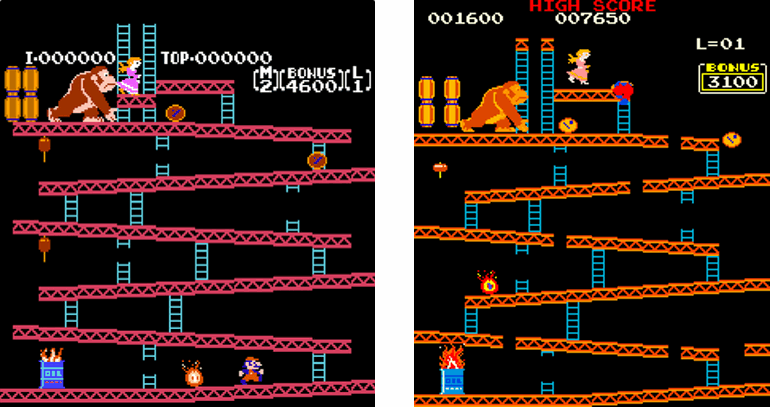
Elcon made a straight-up identical Donkey Kong clone. According to the judge, Crazy Kong “embodies audio-video material, including the characters on the screen and the sound, that is virtually identical” to Donkey Kong. Nintendo v. Elcon, 564 F. Supp. 937 (ED Mich 1982). Crazy Kong copied every detail. Predictably, this is copyright infringement.
Play: Donkey Kong v. Crazy Kong.
Making an identical clone is always copyright infringement. The following three cases reached the same predictable result:
- “Puck Man”, an identical clone of Pac-Man, was copyright infringement in Midway v. Artic, 704 F.2d 1009 (7th Cir. 1983)(appeals court decision). The defendant, Artic, even copied the name “Puck Man” from the original Japanese version of the game. Midway v. Artic, 547 F.Supp. 999 (ND Ill 1982)(trial court decision). Play: Pac-Man v. Puck-Man (I’m not sure which “Puckman” this is).
- “Space Defense”, an identical clone of “Defender” was copyright infringement in Williams Electronics v. Artic International, 685 F.2d 870 (3rd Cir. 1983). Play: Defender
- “Scramble”, an identical clone of “Scramble” was copyright infringement in Stern Electronics v. Kaufman, 669 F.2d 852 (2nd Cir. 1982).
Takeaway: Identical cloning is copyright infringement.
Fraternal Twins: Are the Games “Substantially Similar”?
Games that are similar, but not identical, to an original may still be infringing. For these similar games, we ask whether an ordinary video gamer would think the clone is “substantially similar” to the original? This is a murky question. Copyright infringement isn’t just about how much of the original game was copied, it’s about what types of games elements were copied. We need to filter away the unprotectable elements like ideas, useful articles and clichés, and then compare what’s left. If the remaining game elements are “substantially similar”, then we have an infringing clone. Let’s look at some examples.
Copying Ideas is Not Infringement: Asteroids v. Meteors (1981)
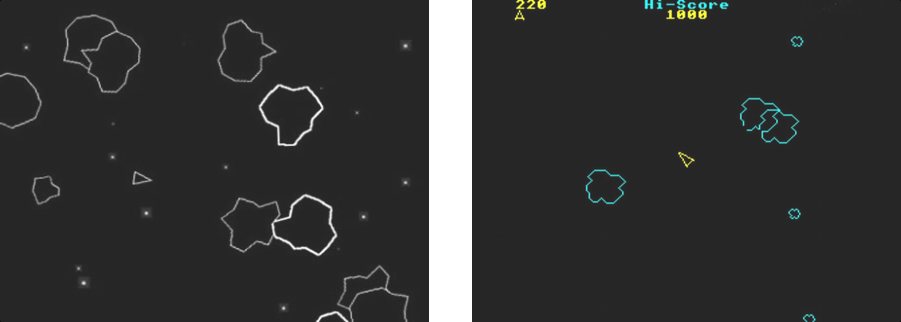
Note - this image (right) is for the wrong “meteors” game. I’m looking for a more correct replacement. See this video and this article for more info. Hat tip to Herman Hermitage for pointing this out.
"The probability of successfully navigating an asteroid field is approximately 3,720 to 1." -- C3PO
In this case, Atari made the original Asteroids game and Amusement World made a knockoff called Meteors. Atari was not amused and it sued for copyright infringement.
The judge compared Asteroids to Meteors and found 22 similarities. He decided that the “defendants based their game on plaintiff’s copyrighted game; to put it bluntly, defendants took plaintiff’s idea. However, the copyright laws do not prohibit this.”
The 22 similarities involved the graphics, game mechanics and sound. According to the judge, they were all part of the unprotectable “idea” of a “video game in which a player fights his way through space rocks and enemy spaceships.”
The court also noted 9 differences, including:
-
Meteors is in color, while Asteroids is in black and white. The symbols for rocks and spaceships in Meteors are shaded to appear three-dimensional, unlike the flat, schematic figures in Asteroids.
-
At the beginning of Meteors, the player’s spaceship is shown blasting off the earth, whereas “Asteroids” begins with the player’s spaceship in outer space.
-
The player’s spaceship in Meteors fires faster and can fire continuously, unlike the player’s spaceship in Asteroids, which can fire only bursts of projectiles.
-
In Meteors, after the player’s spaceship is destroyed, when the new spaceship appears on the screen, the game resumes at the same pace as immediately before the last ship was destroyed; in Asteroids the game resumes at a slower pace.
These changes were enough to avoid infringement, at least in 1981. “Defendants used plaintiff’s idea and those portions of plaintiff’s expression that were inextricably linked to that idea [note: this is the “merger rule”]. The remainder of defendants’ expression is different from plaintiff’s expression. Therefore, the Court finds that defendants’ Meteors game is not substantially similar to and is not an infringing copy of plaintiff’s Asteroids game.” Atari v. Amusement World, 547 F.Supp. 222 (D. Md. 1981).
Takeaway: Copying a game’s “ideas” is not infringement. The idea of a spaceship blasting out of an asteroid field is not copyrightable. The expression of that idea is copyrightable, but in this particular case, the expression in Meteors was different from the expression in Asteroids. No infringement.
Copying Creative Expression is Infringement: Pac-Man v. K.C. Munchkin (1982)
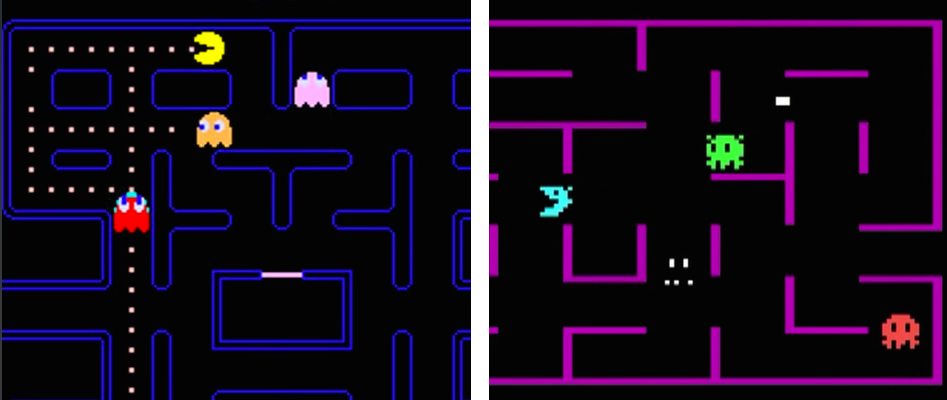
K.C. Munchkin was an early Pac-Man clone, but not an identical copy. This means the court needed to “filter out” the unprotectable elements before looking for substantial similarity and copyright infringement. The judge first separated the unprotectable idea of Pac-Man:
PAC-MAN is a maze-chase game in which the player scores points by guiding a central figure through various passageways of a maze and at the same time avoiding collision with certain opponents or pursuit figures which move independently about the maze. Under certain conditions, the central figure may temporarily become empowered to chase and overtake the opponents, thereby scoring bonus points.
The court then filtered out the unprotectable scènes à faire (i.e., stock video game elements):
The maze and scoring table are standard game devices, and the tunnel exits are nothing more than the commonly used “wrap around” concept adapted to a maze-chase game. Similarly, the use of dots provides a means by which a player’s performance can be gauged and rewarded with the appropriate number of points, and by which to inform the player of his or her progress. Given their close connection with the underlying game, K.C. Munchkin’s maze design, scoring table, and “dots” are sufficiently different to preclude a finding of infringement on that basis alone.
The court then looked at Pac-Man’s protectable creative expression. A maze-chase game “does not dictate the use of a ‘gobbler’ and ‘ghost monsters.’ Those characters are wholly fanciful creations, without reference to the real world.” Finally, comparing only the protectable creative elements, the court found copyright infringement:
The K.C. Munchkin gobbler has several blatantly similar features, including the relative size and shape of the “body,” the V-shaped “mouth,” its distinctive gobbling action (with appropriate sounds), and especially the way in which it disappears upon being captured. An examination of the K.C. Munchkin ghost monsters reveals even more significant visual similarities. In size, shape, and manner of movement, they are virtually identical to their Pac-Man counterparts. K.C. Munchkin’s monsters, for example, exhibit the same peculiar “eye” and “leg” movement. Both games, moreover, express the role reversal and “regeneration” process with such great similarity that an ordinary observer could conclude only that North American copied plaintiffs’ Pac-Man.
Atari v. Philips, 672 F.2d 607 (7th Cir. 1982).
Takeaway: The idea of a maze-chase game is not copyrightable, and the game mechanics that necessarily flow from the idea are not copyrightable. However, the creative expression of a gobbler and ghosts, the sound effects and the “role reversal” mechanism are protectable video game elements.
Play: K.C. Munchkin.
Porting is Infringement: Galaxian v. Galaxian (1982)
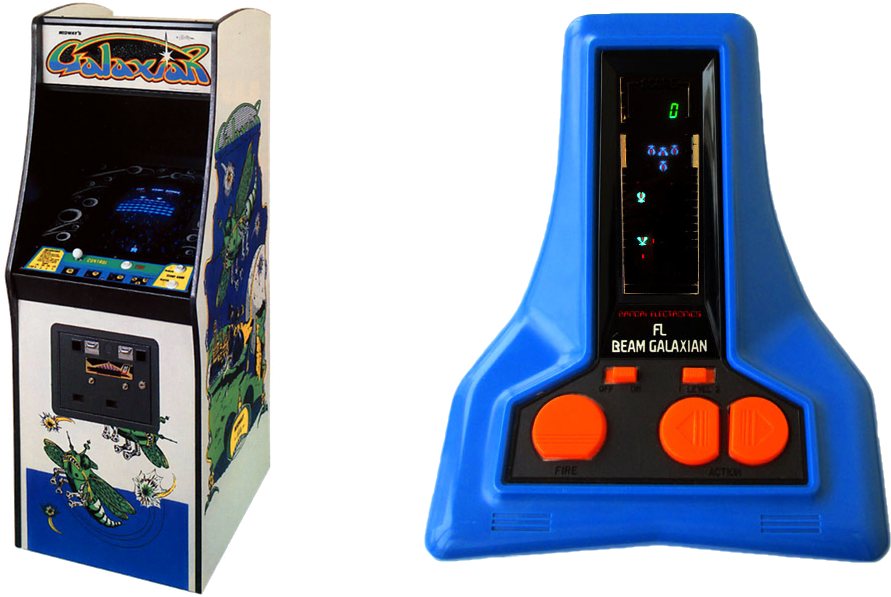
Midway made the arcade game Pac-Man, and Bandai cloned it with the handheld Packri Monster. Midway made the arcade game Galaxian, and Bandai cloned it with a handheld game called… Galaxian. Let’s talk about Galaxian.
As always, the judge first separated the unprotectable idea of the Galaxian game from its expression.
Here, the idea of Midway’s Galaxian is relatively simple and easily expressed: it is an outer space video game in which the player controls a rocket ship defending itself against a swarm of computer-controlled attacking aliens who attempt to bomb and collide with the player’s ship.
With the “idea” out of the way, the Judge dug into Bandai for copying so much of Galaxian’s creative expression:
It is also clear that, in expressing its version of the game idea, there was no necessity for Bandai to mimic Midway’s expression of this idea which involves such elements as the particular insectile shape of the aliens, their movements, and the musical theme.
The judge reviewed the expert opinion of two music professors, and agreed that the “musical themes of the two Galaxian games are fundamentally identical.” Likewise, the alien enemies were similar. “The Bandai aliens are unmistakably insectile as are those in Midway’s game. In addition, Bandai’s insect characters bear a close resemblance to Midway’s, both having brightly lighted eyes and two-toned bodies.” The backgrounds were similar (both set in space), and both games had “the same sort of sequential lighting of the stars, creating the same illusion that the characters are moving through space toward the top of the screen.”
Finally, the judge looked at the game play of both Galaxians, and found them similar as well. “Bandai game’s play and sequence of images is extremely similar to Midway’s. Thus, the Bandai aliens fly in a pack and peel off to attack singly or in small groups. As they attack, they invert, as do the Midway creatures. Bandai’s aliens also appear to flap their wings as they fly and attempt to collide with the player’s ship.” Midway v. Bandai, 546 F.Supp. 125 (D. NJ 1982).
Procedural Note: Galaxian v. Galaxian is an order on a “motion for summary judgment.” This is a type of early motion where a litigant basically says “my case is so strong that we don’t need a trial, and I should win right now.” While the judge thought Midway had a strong case for copyright infringement, it was not so strong that Midway could win on a “motion for summary judgment.”
Takeaway: Defending a spaceship against swarming alien bad guys is an unprotectable idea. The particular insectile shape of the aliens and their attack patterns and animations are protectable “creative expression.”
Play: Galaxian for DOS (1983).
No Infringement: Hyperball v. Rapid Fire (1983)
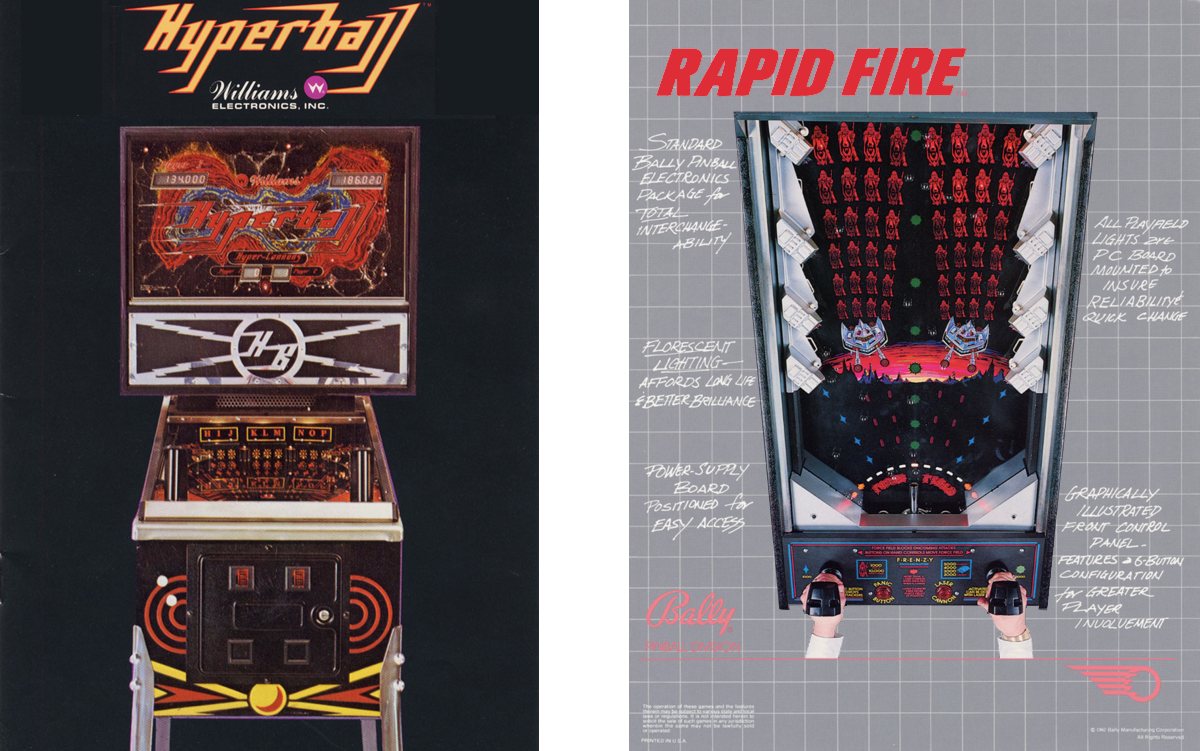
Williams Electronics made Hyperball, a pinball machine with built-in video game elements. Soon after its release, Bally made Rapid Fire, another pinball machine with video game elements.
The judge first separated the unprotectable ideas from the copyrightable expression, and found that “many elements of Hyperball are unprotected. The color, shapes and placements of the targets, ball cannon, grip handles, and indicator lights on the targets, the use of lettered targets to assist the player in scoring, and the shape of the speaker and back box” were functional and non-protectable. In addition, “The colors, shapes and locations of these items have no conceptual significance apart from the role they play in the mechanical operation of the game.”
After separating out the functional elements, the judge compared the remaining copyrightable elements. He started by comparing some specific details:
In viewing the two games solely with reference to their copyrightable features, one is struck by the almost complete absence of substantial similarities. The Hyperball playing field contains three columns of thunderbolts. Rapid Fire has only two columns of aliens carrying shields which pass ammunition to two guns. Nothing like the aliens, shields, ammunition or guns appears on the Hyperball playing field. The thunderbolts and aliens are roughly the same color, but there the similarity ends. Hyperball’s thunderbolts point toward an oval area on which the logo “Energy Center” appears. Below that the word “Hyperball” in lighted block letters appears, and below that “Hyperball” is again written in stylized italics. The Rapid Fire playing field contains no oval area but rather variously colored dotted lines that radiate out from a dotted line in the shape of a semicircle, with the words “Force Field” written in a gothic style below the semi-circle. Hyperball has several “bombs” arrayed along the side of the playing field, but none of the various colored dotted lines that are on the Rapid Fire field.
The judge also compared the overall impression of the two games:
But even more important than these specific dissimilarities is the overall difference in the aesthetic impressions generated by the two games. Hyperball displays thunderbolts; the player’s adversary is an impersonal natural force represented by geometric figures. Rapid Fire displays enemy creatures, humanoid in appearance. The Rapid Fire player’s enemy is more personalized and not simply a geometric shape.
The differences between the specific details and between the overall impressions were enough to differentiate Rapid Fire from Hyperball. There was no “substantial similarity” and therefore no copyright infringement. Williams Electronics, Inc. v. Bally Manufacturing, 568 F.Supp. 1274 (ND Ill 1983).
Takeaway: A “pinball machine with video game elements” is an unprotectable idea. Rapid Fire copied that idea, as it’s allowed to do.
No Infringement: Tricky Trapper v. Mouser (1987)
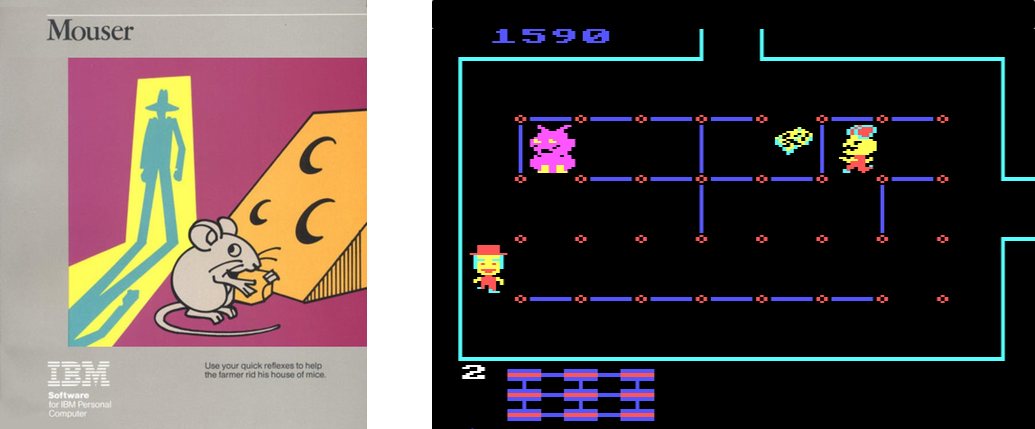
The copyright analysis in Tricky Trapper v. Mouser is similar to the Asteroids v. Meteors case. IBM’s Mouser game was suspiciously similar to Frybarger’s Tricky Trapper, so Frybarger sued for copyright infringement. The court noticed several similarities between the two games, but decided that IBM had only copied from the game’s idea, not its expression. The judge specifically identified some of the basic game mechanics as not protectable:
-
Board: The screen of each game is filled with straight rows of pivot points on a solid colored background. Some of the pivot points are connected by solid lines.
-
Hero: Both games have a single protagonist that moves vertically and horizontally, and rearranges the solid lines to capture bad guys and earn points.
-
Bad Guys: In both games, there are several bad guys to capture. The bad guys move toward the hero, and if they catch him, he dies.
Frybarger v. IBM, 812 F.2d 525 (9th Cir. 1987).
Anyone have a Tricky Trapper screenshot from an Apple II? Both images above are from Mouser. I’d love to know what Tricky Trapper actually looked like.
Sports Games
Video Games that simulate sports (baseball, soccer, karate) or public-domain card games (like poker) get a very “thin” type of copyright protection. It can stop identical clones, but not much else.
No Infringement of Karate Champ (1988)
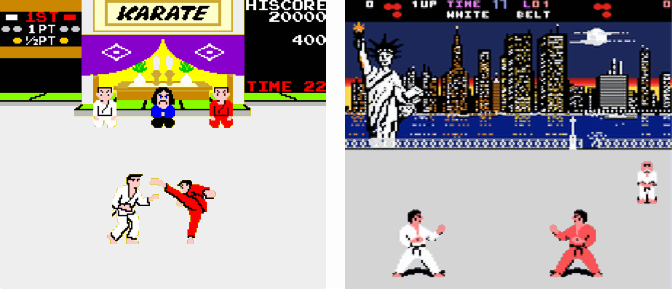
“World Karate Championship” (right) is a clone, more or less, of “Karate Champ” (left). The two games have similar graphics and game play. The court first filtered out the unprotectable game elements. Data East could not copyright the idea of a karate game, nor any game mechanics that necessarily flow from that idea (the “merger” rule). The unprotectable elements
consist of the game procedure, common karate moves, the idea of background scenes, a time element, a referee, computer graphics, and bonus points, result from either constraints inherent in the sport of karate or computer restraints. After careful consideration and viewing of these features, we find that they necessarily follow from the idea of a martial arts karate combat game, or are inseparable from, indispensable to, or even standard treatment of the idea of the karate sport. As such, they are not protectable. Data East v. Epyx, 862 F.2d 204 (9th Cir. 1988).
As a result, there was no copyright infringement. Epyx copied the “idea” of a Karate video game, but not the non-copyrightable graphics and game mechanics that necessarily flowed from that idea.
Takeaway: There is no copyright protection for the idea of a game based on a sport, or for any game elements that necessarily flow from that idea.
Play: Karate Champ (1985)(Data East) v. World Karate Championship (1986)(Epyx)
Now let’s look at a case involving Street Fighter II - a fighting game with a much looser basis in reality.
No Infringement of Street Fighter II (1994)
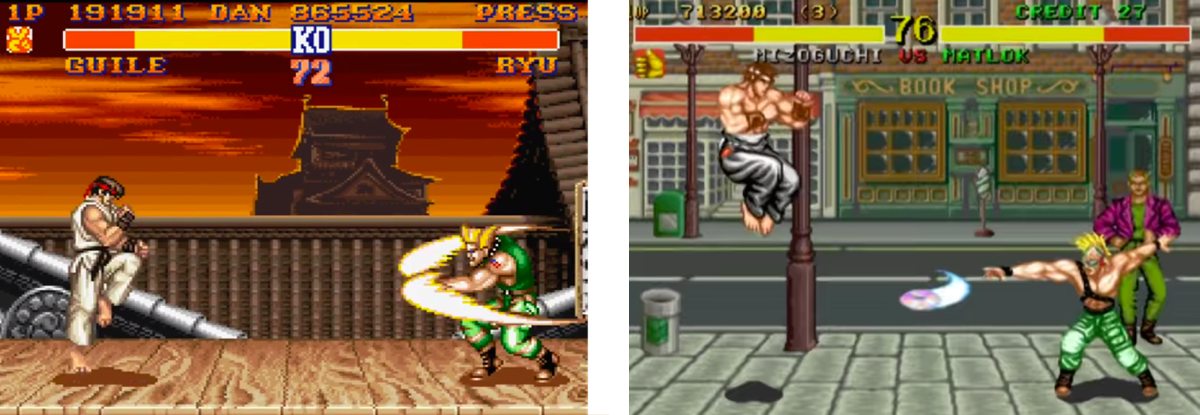
The creative elements of video games merit stronger copyright protections than the non-fiction elements. Since Street Fighter II was largely based on non-fiction karate (IMO, a debatable premise), the judge gave the game a narrow scope of copyright protection:
… there is no question that the games involved in those three cases -– Pac-Man, Galaxian and Donkey Kong –- were far more fanciful than many of the elements presented in Street Fighter II.
While Fighter’s History (right) copied most of its details and game play from Street Fighter II, it was careful not to copy the creative game elements:
For example, although Guile and Matlok both have spiky hair and wear similar clothing, they are not identical to one another. Guile is a military figure who wears military garb and has a military base as his home stage. Matlok is a “punkrocker” whose characterization is underscored by his tough appearance and “breakdance” type moves. Their magic projectiles, while similar in appearance, are not identical. In keeping with his personality, Matlok throws a spinning compact disc, the form of which is apparent in some video sequences. Guile, on the other hand, throws a Ch’i mental energy ball and shouts “sonic boom” upon its release. This is in keeping with his military persona.
The judge also excluded any scènes à faire elements (i.e., stock elements, cliches, stereotypes) from its copyright analysis. The judge discussed the “vitality bar” and the winner designation. “Neither these individual features, nor their particular compilation in Street Fighter II are original to Capcom. Rather, they are better viewed as unprotectable scènes à faire.”
The court also excluded game control sequences from its analysis under the merger doctrine:
the control sequences presently at issue cannot be expressed in limitless ways. Rather, the expression of an idea and the underlying idea frequently merge…. The universe of possible joystick combinations is further restricted by the need to have the control sequence emulate the natural movements of the body. To make the game realistic and easy to learn, a developer must have its control sequences follow the natural flow of the fighter’s body. The player must be allowed to manipulate the control panel in an intuitive manner if he or she is going to become proficient at the game. For example, to mirror the physical aspects of throwing an object, the developer would want to choose a joystick/button control sequence that consists of pulling the joystick backwards to follow the arms as they draw back and then moving the joystick forward and hitting a punch button as the character winds up and releases the object. The idea of throwing an object and its expression as reflected in a distinct control sequence will, therefore, coincide.
Some special moves were unprotectable “scènes à faire”, while others were copyrightable creative expression. According to the court, these 7 moves were not protectable: “(1) Sagat’s ‘tiger knee’ which is a common kickboxing move; (2) E. Honda’s ‘knee bash’ which is a common wrestling move; (3) Vega’s mid-air throw which is a basic fight maneuver; (4) Vega’s floor slide which again is a basic fight maneuver; (5) Balrog’s ‘dashing punch’ which is a simple punch; (6) Zangief’s ‘backwards throw’; and (7) Zangief’s ‘body leap’ both of which are common wrestling moves.” Two special moves were protectable: “Chun Li’s head stomp and E. Honda’s 100 hand slap.”
Since Fighter’s History only copied (a) non-protectable functional game elements, and (b) non-protectable scènes à faire, it was not infringing the Street Fighter II copyright. CapCom v. Data East (ND CA 1994). Check out the appendix of the case for a detailed copyright analysis of the fighters, special moves and combos.
Takeaway: There are three points to take away from this case. Intuitive game controls are “functional” and therefore not copyrightable. Common wrestling moves are not copyrightable, but magical moves (with no basis in reality) are protectable as creative expression. Original video game characters are copyrightable, but stereotypes are not.
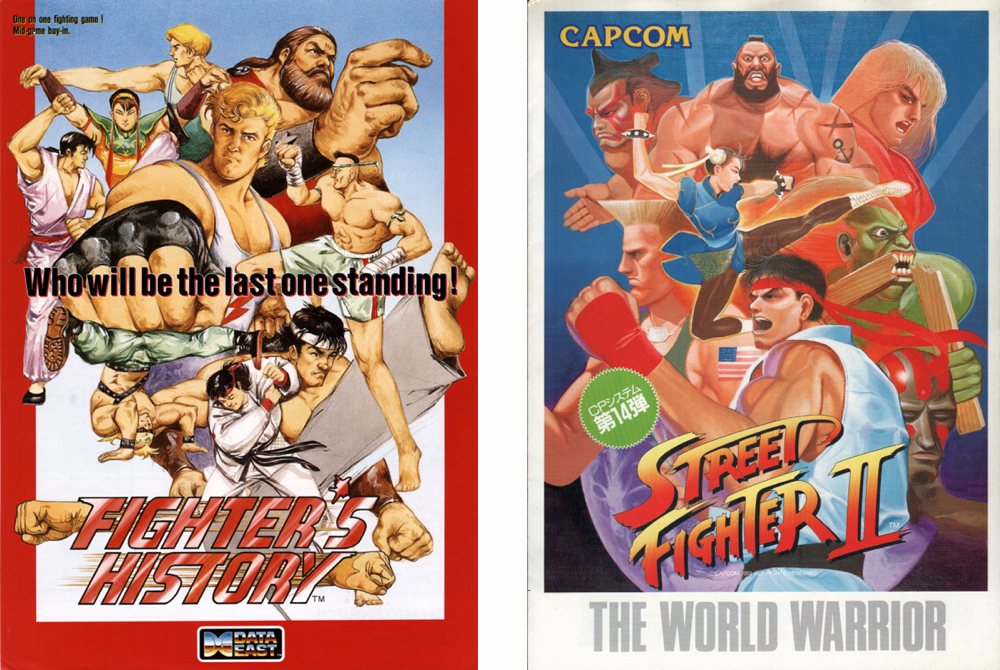
Comment: I’ve never played Fighter’s History, but it looks like a Street Fighter II ripoff. If I were the judge, I’d call it copyright infringement.
Identical Clones Infringe Even Thin Copyright: Double Up Joker Poker (1986)
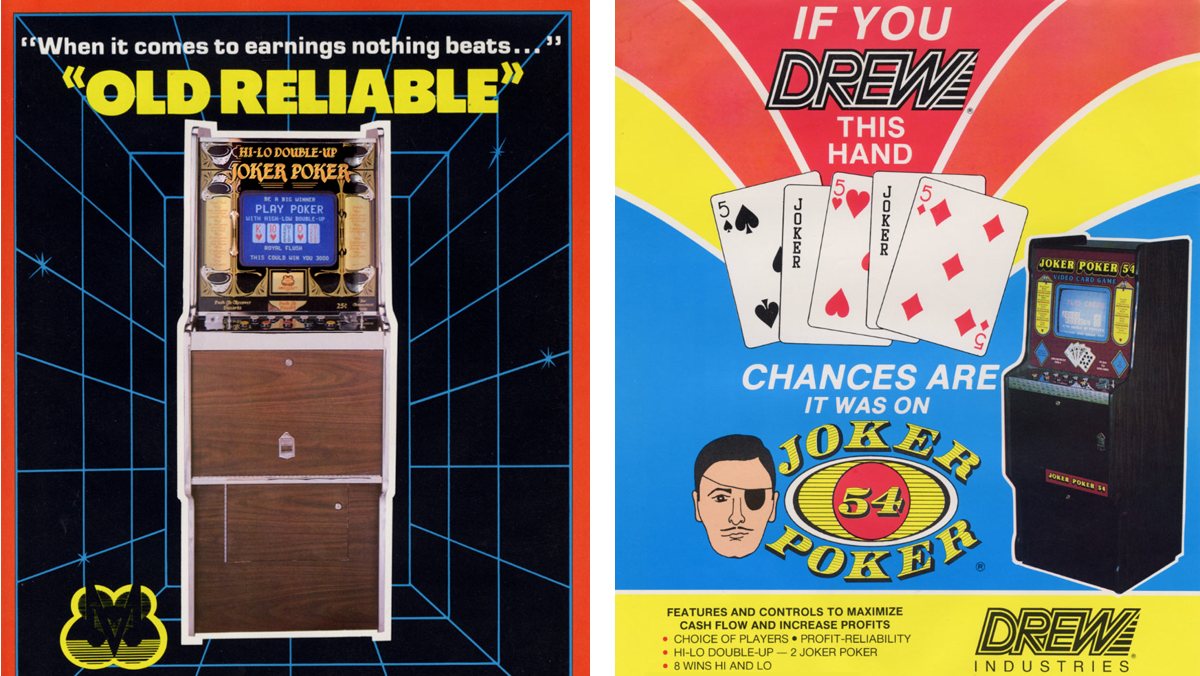
Kramer Manufacturing made Hi-Lo Double Up Joker Poker (left). Soon after, Drew Distributing and Lynch Enterprises made Joker Poker 54 (right). Kramer sued for copyright infringement.
Poker, like karate, is public domain and no one owns a copyright to it. However, Hi-Lo Double Up Joker Poker was poker with a few additional twists and some original artwork. The judge decided that these little additions gave the game just a “taint of originality,” and that this sliver of originality warranted “thin” copyright protection.
Thin copyright protection only works against nearly identical clones. But Drew’s clone replicated Kramer’s original game so closely that it triggered infringement, despite the thin protection. Drew’s game replaced the original “Kramer” logo with its own logo, but otherwise Joker Poker 54 copied every detail of the original game, right down to the easter egg:
Kramer Manufacturing embedded in its program a hidden legend that would appear only when the game’s buttons were pressed in an abnormal sequence. The defendants’ program shows that the legend is included in its copy.
The judge called the two games “virtually identical” and noted that the dissimilarities “appear quite obviously to be the result of a studied effort to make minor distinctions between the two” games. The defendant was trying “to appropriate the plaintiff’s design either outright or by frivolous variation.” Kramer Manufacturing v. Andrews, 783 F. 2d 421 (4th Cir. 1986)
Takeaway: Video Games based on old card games or sports will receive only thin copyright protection. Thin copyright might catch identical clones, but not much else. In this case, the clone was close enough to the original to infringe even a thin copyright.
Trackball Control Not Copyrightable: Golden Tee Golf (2005)
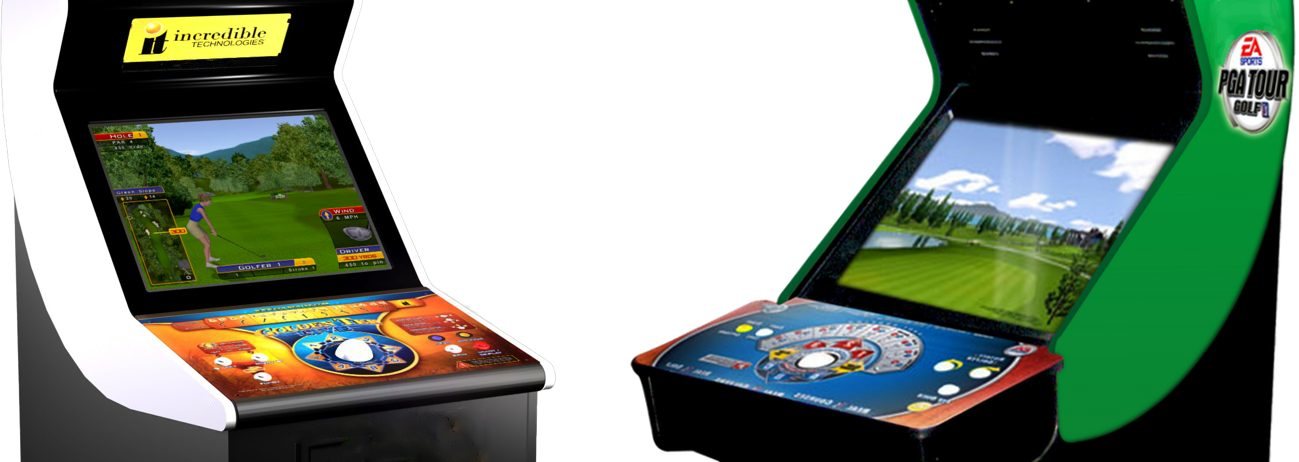
Incredible Technologies made the popular Golden Tee arcade game (left). Virtual Technologies made PGA Tour (right) with the explicit purpose of cloning Golden Tee. The games and controls were similar:
The size and shape of PGA Tour Golf’s control panel, and the placement of its trackball and buttons, are nearly identical to those of Golden Tee. The “shot shaping” choices are depicted in a similar way and in the same sequence. Although the software on the two games is dissimilar, both allow a player to simulate a straight shot, a fade, a slice, a draw, a hook, etc. by the direction in which the trackball is rolled back and pushed forward. Incredible Technologies v. Virtual Technologies, 400 F. 3d 1007 (7th Cir. 2005).
Before comparing the two golf games, the court filtered out the standard golf themes under the scènes à faire doctrine:
In presenting a realistic video golf game, one would, by definition, need golf courses, clubs, a selection menu, a golfer, a wind meter, etc. Sand traps and water hazards are a fact of life for golfers, real and virtual. The menu screens are standard to the video arcade game format, as are prompts showing the distance remaining to the hole. As such, the video display is afforded protection only from virtually identical copying. Incredible Tech. v. Virtual Tech..
Condescending golf announcers are apparently scènes à faire. Under copyright law, this means that any golf game can use condescending announcers, but games can’t copy condescending phrases identically. Fortunately for PGA Tour, it didn’t copy the identical phrases:
“the fairway would be over there” and “I don’t think that’s going to help a whole lot” in PGA Tour versus “That can only hurt,” “You’ve got to be kidding,” and “You can lead a ball to water but …” from the Golden Tee announcers. Incredible Tech. v. Virtual Tech..
Useful articles, like the trackball control, are not copyrightable. A useful article is defined in the copyright act as “an article having an intrinsic utilitarian function that is not merely to portray the appearance of the article or to convey information.” The trackball system of operating the game was considered a useful article, and therefore not subject to copyright protection.
Takeaway: Video game controls (like a trackball) are entitled to very little, if any, copyright protection.
Play: Golden Tee Golf
Recent Video Game Copying Cases
Games Can Infringe Movies, But Dead Rising Didn’t (2008)
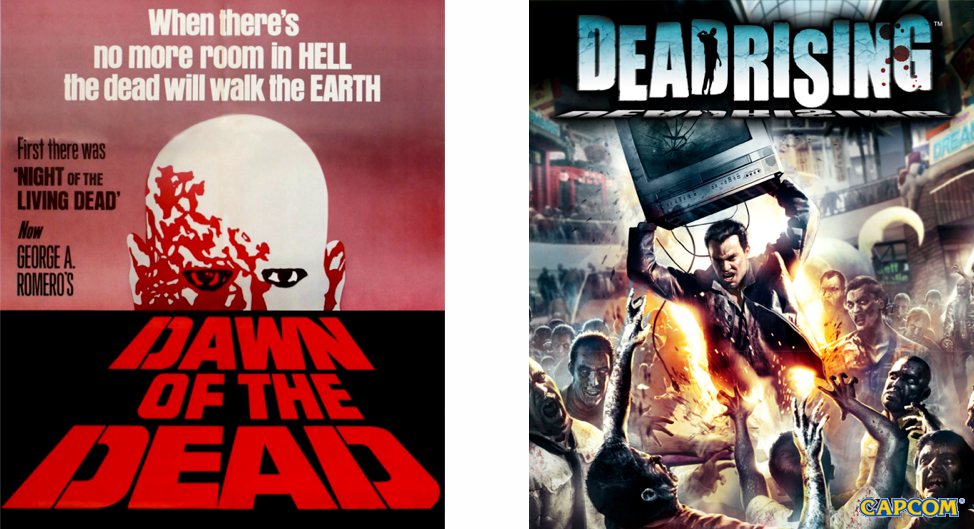
Capcom’s Dead Rising game took inspiration from George Romero’s 1979 zombie classic Dawn of the Dead. In its copyright analysis, the judge noted several similarities. In both works: (1) the story kicks off with a helicopter ride to a rural mall infested with zombies; (2) the mall has a gun shop; and (3) propane tanks and chainsaws are used in creative ways to kill zombies. Both works also parody rampant consumerism and critique sensational journalism.
Before comparing the game to the original movie, the court filtered out the unprotectable scènes à faire (i.e., stock zombie elements). Unfortunately for Romero’s Dawn of the Dead, all of the similarities were “driven by the wholly unprotectable concept of humans battling zombies in a mall during a zombie outbreak.” Since Capcom’s video game only copied unprotectable ideas, there was no copyright infringement. Capcom v. MKR Group, 2008 WL 4661479 (N.D. Cal. 2008).
Takeaway: Using chainsaws to kill zombies is scènes à faire. It’s cliché, not copyrightable expression.
Tetris Infringed by Mino (2012)
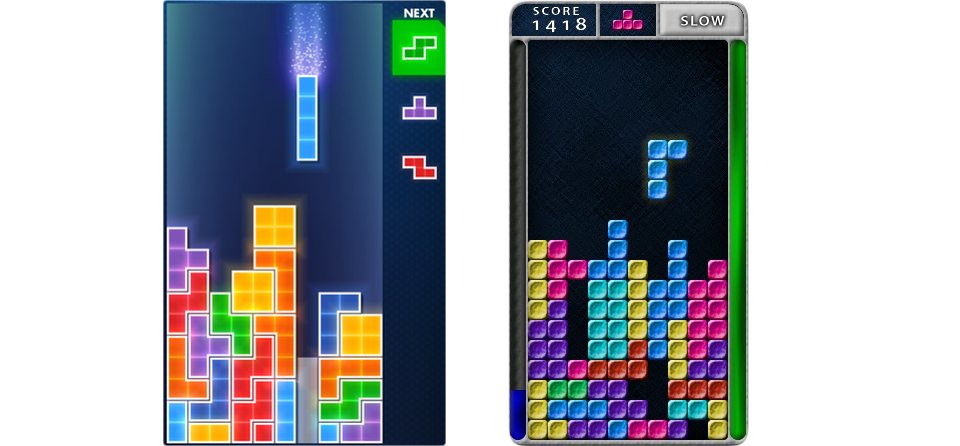
Desiree Golden, just out of college, started a video game company called Xio Interactive. Before releasing Mino, a Tetris clone for iOS (right), she did her copyright homework:
Xio researched copyright law, both through its own independent studying and based on advice of counsel… Based on this research, Xio believed it could freely copy any part of Tetris that was based on a “rule of the game” or that Xio viewed as being functional to the game.
She correctly understood the basic rules of copyright law, and that the idea of a falling-block puzzle game is not part of the Tetris copyright. However, when she tried to draw the line between the unprotectable idea of Tetris and its protectable creative expression, she drew it in the wrong place, and gave herself too much leeway to copy.
Here’s how the judge identified the unprotectable idea of Tetris:
Tetris is a puzzle game where a user manipulates pieces composed of square blocks, each made into a different geometric shape, that fall from the top of the game board to the bottom where the pieces accumulate. The user is given a new piece after the current one reaches the bottom of the available game space. While a piece is falling, the user rotates it in order to fit it in with the accumulated pieces. The object of the puzzle is to fill all spaces along a horizontal line. If that is accomplished, the line is erased, points are earned, and more of the game board is available for play. But if the pieces accumulate and reach the top of the screen, then the game is over. These then are the general, abstract ideas underlying Tetris and cannot be protected by copyright nor can expressive elements that are inseparable from them.
While copyright doesn’t protect these basic ideas about a falling-block puzzle game, it does protect the creative expression of these ideas in Tetris:
The style, design, shape, and movement of the pieces are expression; they are not part of the ideas, rules, or functions of the game nor are they essential or inseparable from the ideas, rules, or functions of the game.
Xio was free to program a puzzle game with the playing field designed “in an almost unlimited number of ways”…. Xio was not limited to those precise dimensions and was free to take the general idea of having a long game board and express it in its own unique way. For example, it could have had a field three times as high as it is wide or 15 units high by 8 units wide, without copying the exact game dimensions and infringing the look and feel of Tetris’s expression.
The judge specifically called out the 7 basic Tetris shapes as protectable expression: “Xio was also free to design a puzzle game using pieces of different shapes instead of using the same seven pieces used in Tetris.” The judge also decided that the Tetris visual cues were creative expression:
Similarly, Mino also displays “garbage” lines, “ghost” pieces, and a preview of the next piece to fall in order to enhance game play as does Tetris…. I am not persuaded that these features constitute either the ideas or rules of Tetris or are necessitated by game play. Moreover, even if these were rules, it is Xio’s copying the same look and feel of these features that lead me to find it has infringed Tetris Holding’s copyright. Xio was free to design other ways to alter game play, making it more or less difficult, using its own original expression to express these features, which it has chosen not to do.
Mino infringed the Tetris copyright because it copied the exact same 7 Tetris shapes, used the same board dimensions (10 x 20), the same shape movement down the board, and the same visual cues like garbage lines, ghost pieces and preview pieces. Tetris v. Xio Interactive, 863 F.Supp.2d 394 (D. NJ 2012).
Takeaway: Copyright infringement law is not easy. Even careful developers can get it wrong, and reasonable people can disagree about where to draw the line between idea and expression.
Note: To me, the 7 basic Tetris shapes seem more like idea than expression. There are only 7 tetrominos. Selecting all of them seems like embodiment of the idea of tetrominos. Imagine a falling puzzle game with trominos (left) or pentominos (right). Sure it’s possible, but would you really want to play it?
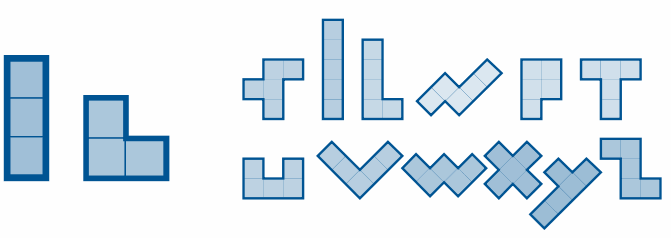
Infringement in Triple Town v. Yeti Town (2012)

Spry Fox made Triple Town (left), LolApp made Yeti Town (right). Spry Fox noticed some suspicious similarities, and sued for copyright infringement. As usual, the copyright analysis starts by filtering out the unprotectable ideas:
The idea underlying Triple Town is that of a hierarchical matching game, one in which players create objects that are higher in the hierarchy by matching three objects that are lower in the hierarchy. Frustrating the player’s efforts are antagonist objects; aiding the player are objects that destroy unwanted or ill-placed objects. Spry Fox’s copyright gives it no monopoly over this idea.
In addition to the unprotectable idea, Triple Town used some unprotectable scènes à faire. This included using points and coins to reward progress, visual game tips in the margins, and incorporating an in-game marketplace for buying upgrades. This is all standard video game fare, not copyrightable expression. The court also filtered out unprotectable game mechanics. Using a six-by-six game grid is not an expressive choice. “A grid that is too small would make the game trivial; a grid that is too large would make it pointless.”
Looking at the remaining protectable game elements, the court decided they were probably infringing:
In Triple Town, the antagonist is a bear. In Yeti Town, the antagonist is a yeti… bears and yetis are both wild creatures….
The object hierarchy is similar. Progressing from grass to bush to tree to hut is similar to progressing from sapling to tree to tent to cabin. Perhaps more importantly, the object hierarchy coupled with the depiction of the field of play comprise a setting and theme that is similar to Triple Town’s.
The judge also weighed the wisdom of video game bloggers: “The bloggers, who are ordinary observers of video games, find Yeti Town and Triple Town to be substantially similar.” Spry Fox v. LolApps (WD WA 2012).
In any event, this case was settled before a final decision was reached. The settlement details are confidential, but Yeti Town is no longer available in the app store.
Takeaway: Copyright protections for video game mechanics seem to be expanding. This is bad news for cloners. Also, some judges will listen to video game bloggers?
Bang! Role Playing Card Game Copyrightable (2014)

A recent case involving non-video games further solidifies the idea that game mechanics can be copyrightable. In this case, DaVinci made the original “Bang!” game (left), and accused Ziko of copyright infringement for its “Legend of the Three Kingdoms” game (right). The parties agreed that the game mechanics were identical, but the game art was entirely different:
The parties agree that Bang! and LOTK have nearly identical rules for playing the game. The setting, artwork, and written instructions are substantially different. LOTK is ‘re-set in ancient China instead of the wild-west.’ The ‘ancient Chinese’ themed roles in LOTK (the Monarch, Minister, Rebel, and Turncoat) fulfill the same roles as the Sheriff, Deputy, Outlaw, and Renegade in Bang!.
Drawing on video game cases, the judge decided that the Bang! game rules were not copyrightable. “The similar uses of life points, distance between players, action cards, and rewards and punishments do not constitute actionable copying.” The character roles, unlike game rules, were copyrightable:
The players in both games play virtually identical roles. … such roles and their expression are not merely rules that prescribe what the players may do; the roles and their expression also describe how the players may do it. If the roles describe the content of the players’ interactions in ways that are sufficiently original or creative to merit copyright protection, players’ roles can be protectable.
The Bang! characters and capabilities were also copyrightable:
the corresponding characters in the two games have substantially similar capabilities. Each character card in both games has a name, picture, and a description of the character’s capabilities and life points. The defendants allegedly copied these capabilities and life points, simply changing the names and artwork. The questions are whether these character elements are protected and whether translating the Bang! characters from a Wild West to an ancient China theme infringes that protection.
Given the similarities between the attributes of the characters in Bang! and in LOTK, a reasonable factfinder could conclude that the characters of the two games are substantially similar despite the transposition and translation from the Wild-West theme of Bang! to the ancient China theme of LOTK.
The judge contrasted the fictional Bang! game with the realistic golf simulation case:
There is a limited number of ways for the game designer to show a golfer, a course, a swing, and the ultimate goal: putting the ball in the hole. Such limits do not apply to role-playing games like Bang!. There are nearly infinite ways of expressing the concepts of player elimination or a contest between authorities and their opponents. Instead of choosing a different manner of expressing these concepts, the defendants copied into LOTK protectable elements of DaVinci’s original and creative expression in Bang!
For context, this is a very early decision in the case. The judge isn’t answering the question of whether there is copyright infringement. He is answering the question of whether the plaintiff’s copyright claims are so weak they can be thrown out on a preliminary “motion to dismiss.” Since the plaintiff’s copyright claims were plausible, and so they survived the preliminary motion to dismiss and the case goes on. Da Vinci v. Ziko Games (SD Texas 2014).
Update: In 2016, the court found that the games were not substantially similar, and that there was no copyright infringement:
The undisputed summary judgment evidence shows that Bang!’s characters, roles, and interactions are not substantially similar to those in LOTK. The aspects of the roles, characters, and interactions that are similar are not expressive, and aspects that are expressive are not substantially similar. ZiKo and Yoka are entitled to summary judgment of noninfringement.
This court opinion discusses many of the same cases cited in this blog post :-)
DaVinci Editrice SRL v. ZiKo Games, LLC, 183 F. Supp. 3d 820 (SD TX 2016).

Conclusion
Video game copyright cases turn on whether the clone copied “ideas” (tolerated) or “creative” elements (verboten). Before looking for similarities between the clone and the original, we need to mentally “filter out” the unprotectable game elements using several different techniques:
Idea-Expression Dichotomy. First we filter out the unprotectable “ideas” from the protectable expression.
| Unprotectable | Copyrightable |
|---|---|
| The idea of a maze-chase game. | The expression of a chomping gobbler antagonized by colorful ghosts. |
| The idea of a karate style fighting game. | The expression of E. Honda’s “100 hand slap.” |
| A puzzle where users try to manipulate falling shapes to create gapless rows. | The specific style, design, shape, and movement of the shapes in Tetris |
Merger Rule. If a particular idea can only be expressed in one way, then idea and expression “merge” and neither is copyrightable. Be careful about merger rule decisions in old video game cases, where early technology severely limited the manners in which an idea could be expressed. With modern video game technology, merger is less likely to apply.
Thin Copyright for Realistic Simulations. Games that closely simulate real life receive weaker copyright protection. The more creative, abstract and original the game elements, the stronger the copyright. Video games that simulate sports or pre-existing card games get “thin” copyright protection – protection against identical clones only.
| Thin Copyright | Full Copyright |
|---|---|
| Hi-Lo Double Up Joker Poker, a basic poker simulator. | Pac-Man, a creative maze-chase game. |
| Karate Champ, a basic karate simulator. | Street Fighter II, a fighting simulator with fantasy elements. |
Useful Articles. Copyright does not “extend to any idea, procedure, process, system, method of operation…” 17 USC § 102(b). Game controls like a trackball are unprotectable as useful articles or “methods of operation.”
Scènes à Faire. Copyright doesn’t protect cliches, stereotypes, stock characters or standard treatments. For example, Pac-Man’s dots, Street Fighters vitality bar, and zombie-chainsaw-decapitations are all scènes à faire. In some cases, scènes à faire elements get thin copyright protection, while in others, they get no protection at all.
Framing. Framing the “idea” of the game is critical to the copyright analysis. If the game’s “idea” is defined with more details, it will receive less copyright protection. This is because cloners are free to copy from the details that make up the “idea” of the game. The more detailed the idea, the more freedom to copy. Original game creators can carefully and concisely define of the “idea” of their game and perhaps even use the defined “idea” in their marketing. This can help persuade copyright judges to apply the narrowly defined “idea” of the game in a later copyright infringement analysis, and grant the game broader protection.
Copyright infringement analysis is more an art than a science, and the line between creative expression and unprotectable ideas is famously elusive. As Judge Learned Hand (real name) put it, “Nobody has ever been able to fix that boundary, and nobody ever can.” Nichols v. Universal.

Images via Arcade Flyer Archive, International Arcade Museum, and World of Spectrum.